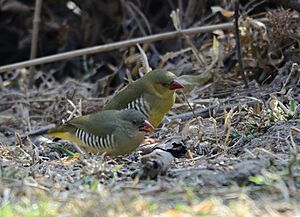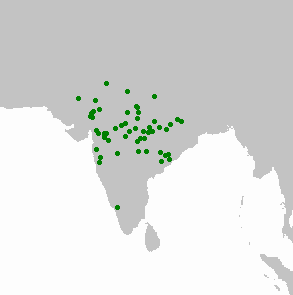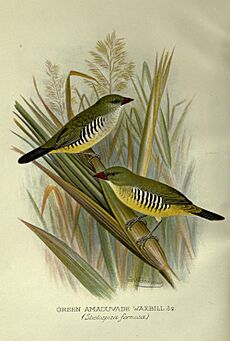Green avadavat facts for kids
Quick facts for kids Green avadavat |
|
|---|---|
 |
|
| A pair at Mt. Abu, India. The slightly duller female in foreground. | |
| Conservation status | |
| Scientific classification | |
 |
|
| Synonyms | |
|
Stictospiza formosa |
The green avadavat or green munia (Amandava formosa) is a small, colorful bird. It has green and yellow feathers, a bright red beak, and cool black "zebra stripes" on its sides. These birds live only in the Indian subcontinent. They used to be very popular as pet birds. The name "avadavat" comes from the city of Ahmedabad in Gujarat, India, which was a big center for trading birds. Sadly, their numbers are shrinking because of this bird trade.
Contents
What Does the Green Avadavat Look Like?
The green avadavat is about 10 centimeters (4 inches) long. It's green on top and yellow underneath. Its sides have black and white stripes, and its beak is a waxy red. Both male and female birds have light tips on their wing feathers.
The top part of their body is olive green. The feathers covering their tail are more yellow. Their tail is black and rounded. The chin is light yellow, and the lower chest, belly, and bottom are brighter yellow. The sides of their body have brown and white stripes. Their legs are a pale, fleshy color or brown.
The female bird is usually a bit lighter in color than the male. Young birds are duller and have a black beak. They also do not have the stripes on their sides yet.
Where Do Green Avadavats Live?
These birds mostly live in dry scrublands and farm areas. You can often find them close to water. The biggest groups of green avadavats are in central and north-western India.
They are well known in central India, especially around Oriya village in southern Rajasthan. You can also find them in central Uttar Pradesh, southern Bihar, and West Bengal. Their range goes south to southern Maharashtra and northern Andhra Pradesh. Some birds have been seen further south in Wynaad, northern Kerala. However, it is not clear if these are wild groups.
Reproduction and Habits of Green Avadavats
Green avadavats breed in central India from October to January. They are also known to breed in July. Their nest is shaped like a ball with an entrance on the side. They build it using wide leaves from grass or sugarcane.
These birds can adapt well to changed habitats, which helps them survive. Several pairs might build their nests close together, forming a loose group. They look for food in small groups, especially when it's not breeding season. A female usually lays four to six eggs.
Their song is a high-pitched, warbling sound. It often ends with a long trill. They also make weak "seee" and "swee" sounds.
Protecting the Green Avadavat
The green avadavat has been a popular pet bird for a long time. People have traded them since the late 1800s. They are still common in some places, like Oriya village, Achalgarh, and Guru Shikhar in Mount Abu, Rajasthan. However, their numbers have gone down a lot because of trapping.
In the bird trade, they are sometimes called "green waxbills." Whole groups of these birds are easy to catch using bait and other birds as decoys. Efforts to protect their homes in Mount Abu have helped some groups of birds continue to exist. The forest department in Rajasthan has even made this bird a symbol for the district. A study in 2020 found that losing their natural homes is a big threat to these birds.



